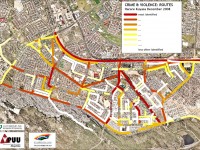Topics:
Urban upgrading
Crime Mapping
Location: Khayelishta township, Western Cape Province, South Africa
Organizers:
City government of Cape Town
Community members
Background: Khayelishta township was created in the 1980s by the apartheid government as a way to depopulate the surrounding overcrowded townships. Since then, Khayelishta has been a magnet for rural-urban migration, an entry point to the greater Cape Town economy. Unfortunately, unemployment and crime rates are high. During apartheid, police had a limited presence in many townships as institutions preventing crime and maintaining public safety. Instead street committees, comprised of elders and other respected community members, tasked themselves with maintaining law and order, including punishing criminals. Police institutions began to work the streets in townships following the end of apartheid; but due to administrative deficits and an inherited lack of trust, street committees remained valuable enforcers of the law. Over time, however, the status and legitimacy of street committees have come in to question, and their influence overall has ebbed as formal institutions seek to assert their influence in township jurisdictions. This tension between formal and informal crime prevention methods – with neither one fully possessing the resources to completely fulfill their mandate – has created a vacuum within which crimes like daylight robberies and muggings continue to thrive.
Project: In order to address crime with the input of community members, the City of Cape Town has developed the Violence Prevention through Urban Upgrading program (VPUU). The first step of the program is to conduct a Baseline Survey and draft a Crime Map, in order to get a sense of the frequency and spatial extent of crime in an area.
Once the main points of crime have been identified in a neighborhood, the program identifies “Safe Node Areas” (SNAs): each SNA is targeted for redevelopment with the aim of reducing crime in that area, and in the community as a whole. Different interventions to improve safety are designed and proposed to the community. In keeping with an holistic approach to crime reduction, interventions either impact the physical environment (as with “Active Boxes” – safe spaces in which to take refuge during a crime situation) or the social dynamic (such as programs meant to mainstream crime awareness in local institutions). Following a “Package of Plans” approach that allows for comprehensive coordination and implementation of proposed projects, VPUU works with community members in many different SNAs to bring plans from concept to fruition.
Results: To date, four Safe Node Areas have been identified. The first round of funding in 2007 led to the improvement of 13 creches; a campaign to improve roads and signage (especially those in crime hotspots); and integration of youth groups within community programs. Financing: At the beginning of the VPUU, a Social Development Fund was established in order to finance crime prevention programs. Three times per year, requests for proposals go out to each SNA. Successful projects’ participants are asked to contribute 10% of the amount awarded in either cash or in-kind contributions: this mechanism helps establish community ownership of the project.
Financing: At the beginning of the VPUU, a Social Development Fund was established in order to finance crime prevention programs. Three times per year, requests for proposals go out to each SNA. Successful projects’ participants are asked to contribute 10% of the amount awarded in either cash or in-kind contributions: this mechanism helps establish community ownership of the project.
Sources:
http://www.capetown.travel/attractions/entry/Khayelitsha_Township_Tour_and_Craft_Market



